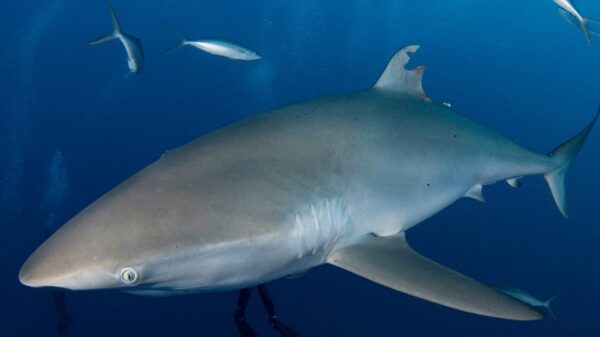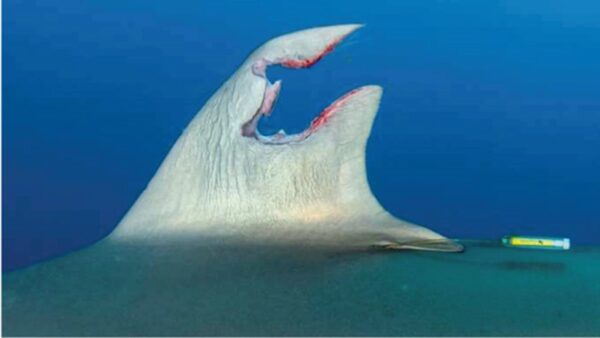Fin repair in sharks is common, though it is rarely full. Typically scar tissue forms in wounds, closing them, offering a small degree of regeneration.
A marine biologist at the University of Miami’s Rosenstiel School of Marine, Atmospheric, and Earth Science, has documented a case of a silky shark with a regenerated dorsal fin, after much of it was lost due to maiming by an unknown person.
The silky shark with a wounded dorsal fin in July 2022. (Photo: Josh Schellenberg)
Prior to this latest observation, only one other instance of fin regeneration in any type of shark has been observed. And no prior cases have been documented of a silky shark regrowing large portions of a lost fin.
Silky sharks (Carcharhinus falciformis) are sleek ocean predators that grow to around 3.5 meters in length (11.5 feet) and used to be one of the most common shark species in the ocean, but are now one of the most consumed species in shark fin markets.
Off the coast of Florida in July 2022, an underwater photographer and diver captured images of a silky shark with a traumatic injury to its dorsal fin. The shark was an adult male, and the photos were looked at by marine biologist Chelsea Black, author of a new study.
In studying pictures taken of the shark, she noted that the injury line traced the contours of what had once been the satellite tag site. Some unknown person had cut the tag off the fin, leaving a massive gap. The piece of missing fin was so large that Black expected the shark would likely die due to difficulties in catching food.
Photograph of the dorsal fin of a male silky shark (C. falciformis) taken during a dive in Jupiter, Florida, on July 31, 2022, by Josh Schellenberg. Credit: Journal of Marine Sciences (2023).
The shark with the injured fin was not seen again in 2022 and was presumed to have left the area of Jupiter, Florida as part of the annual migration. In June of the following year, a male adult silky shark returned to the same area with an unusually shaped dorsal fin. Through photo ID and tag number matching from the previous year the same individual was identified, even though the shape of the dorsal fin had changed significantly.
Black estimated that the shark had lost just over 20% of the fin, and regained approximately 87% of it through rejuvenation.
This story was covered in a number of outlets, including IFL Science, LiveScience, PhysOrg and NWN.
The full paper in the Journal of Marine Sciences can be read here.

